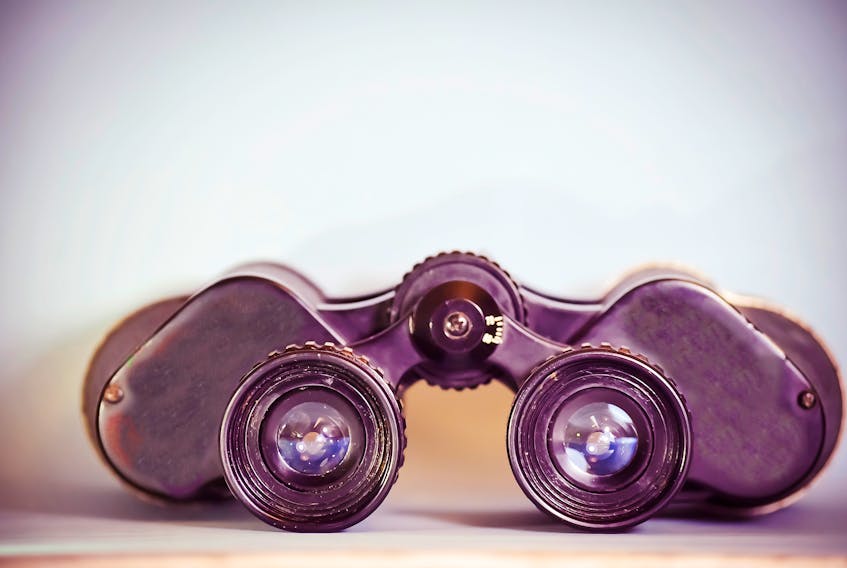COVID-19 forced people to stay home, and perhaps, when the opportunity presented itself, spend more time at the beach or cottage.
Combined with the beautiful summer weather we've had here on the East Coast the past couple of months, people appear to be lingering later at the beach or around their campfire than normal at night, and, as a consequence, were (some for the first time in many years) noticing the night sky more.
One of the most frequent questions I've received throughout the summer has been how to select binoculars for night sky observing. Though I have, upon occasion, made reference in my columns as what to expect when observing nighttime celestial objects with binoculars, perhaps a more detailed explanation as to what exactly to look for in selecting a pair of binoculars, either for yourself or a younger family member, is in order.
Binoculars are an excellent way to begin exploring the night sky; they are versatile (can be used for observing other things than just the night sky), they are portable and require no expertise to set up and use. Viewing with two eyes rather than one is more natural and comfortable, plus they have a wider field of view than a telescope and the object you are viewing is right-side up (as opposed to upside down in most telescopes). They are also relatively inexpensive compared to telescopes.
Those things being said, there are a number of factors to consider when selecting a pair of binoculars. People tend to get hung up on magnification, whether in a telescope or binoculars, equating higher magnification with the magnificent, coloured images of celestial objects seen in astronomy magazines, but nothing could be farther from reality. When you pick up a pair of binoculars, you will see a set of numbers on them (e.g., 5x10). The first number, in this example five, means the binoculars have a magnification of five times (i.e., the object will appear five times closer). These numbers usually range between five and 10, though any binoculars with a magnification larger than 10 times will probably require a tripod to hold them, as they will be very big.
The main problem with higher magnification is that your field of view (i.e., the patch of the night sky you are looking at) decreases in size as magnification increases. The second number is much more important than the magnification number. It refers to the size of each of the two front lenses of the binoculars (singularly called the objective lens) in millimeters (mm).
These lenses are, in essence, the light-gathering part of the binoculars; the larger the objective(s), the more light that is gathered to enter your eyes, the brighter the object you are looking at appears, and the more detail you will see.
When you look at the objective lenses of the binoculars, you will notice two small, bright circles of light (referred to as exit pupils). The size of the objective lens (e.g., 35 mm) divided by the magnification (e.g., 5x) equals the size of the binoculars' exit pupils, expressed in millimeters (i.e., the size of the light cone exiting the binoculars through the rear lenses and striking the observer's eyes - 35mm or 5x is seven millimetres).
This number is important, particularly for older observers, since, ideally, the size of the binoculars' exit pupils should match the size of the pupils of the observer's dark-adapted eyes (when your eyes have self-adjusted to the darkness, usually after about half an hour outside at night, enabling you to see more in the dark). Our eyes change as we grow older, with the dark-adapted pupils of older folks' eyes usually not opening as wide as those of younger folks (especially children).
The only real way to figure out what size exit pupil matches that of your eyes, especially if you are an older observer, is to try different binoculars with different magnifications and objective lens sizes. With the proper binoculars, you might not need to wear your glasses (depending on why you need glasses in the first place) to observe the night sky.
Other factors you need to take into consideration when selecting binoculars for night sky observing are:
- The prisms in the binoculars roof prisms (the binoculars barrels are straight, and, usually, more compact) or Porro prisms (the binoculars have a zig-zag shape, are bigger, and heavier.
- If the glass in the binoculars (both front and rear lenses) made of high-quality glass (e.g., barium crown glass vs borosilicate glass).
- Whether the lenses are coated (coated lenses, though more expensive, provide brighter and higher contrast images);
- How often you are likely to use them, and for what purpose (do you intend to use them for bird watching, sports, or other daytime activities?)
- Your budget (how much are you prepared to pay for a decent pair of binoculars).
Should you buy a pair of binoculars as an introductory means of becoming familiar with the night sky? Yes! For your children? Definitely!
Do you need to spend hundreds of dollars on a pair? Not necessarily. A good, all-round pair of binoculars would be an 8x35mm pair or a 10x50mm pair, though the former would be a bit lighter in weight, and thus easier to carry or hold. The wider field of view of lower power binoculars is usually a plus when it comes to observing the night sky in general.
Although it is ultimately up to you where you purchase your binoculars, and how much you pay for them, I would suggest you buy them from a reputable optics company, one that makes both binoculars and telescopes (e.g., Celestron or Meade) rather than a department store brand (even though they will, likely, be much cheaper). With binoculars, as with most things, you get what you pay for. You will not be doing yourself or your children a favour by purchasing cheap, poor-quality binoculars; you will be disappointed and discouraged from experiencing one of the true pleasures of being outdoors at night: viewing the incredible beauty and diversity of the night sky above you.
This week's sky
Having recently passed superior solar conjunction on Aug. 17, Mercury is not currently visible.
Venus (magnitude -4.24) rises in the east shortly after 2:30 a.m., remaining our "morning star" in the eastern, pre-dawn sky until it fades from sight around 6 a.m.
Mars (magnitude -1.63) is visible around 11 p.m., about seven degrees above the eastern horizon, reaching its highest point (49 degrees) in the southern sky around 4:45 a.m., before becoming lost in the approaching light of dawn shortly after 6 a.m.
Jupiter (mag. -2.62) is visible in the early evening, just as dusk turns to darkness, 16 degrees above the southeast horizon, reaching its highest point in the evening sky around 10:15 p.m., and remaining observable high in the southwest sky until about 1:30 a.m.
Saturn (magnitude +0.27) is Jupiter's constant companion, rising in the southeast shortly after its larger and brighter cohort, and trailing him (about an extended hand's width to Jupiter's left) across the late evening southwest sky, until it, too, disappears from view by about 2 a.m.
Until next week, clear skies
Events:
- Aug. 25 - First quarter moon
- Aug. 30 - Moon at aphelion (farthest distance from the sun)
Glenn K. Roberts lives in Stratford, P.E.I., and has been an avid amateur astronomer since he was a small child. He welcomes comments from readers at [email protected].








